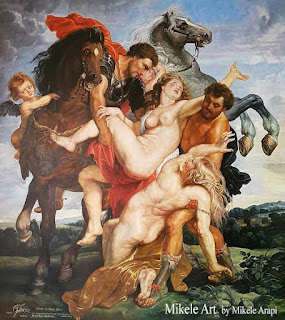Monteleone chariot
Etruscan - 2nd quarter of the 6th century B.C.
Total H. 130.9 cm; length of pole 209 cm / Met
Bronze chariot inlaid with ivory
Scenes from the life of the Greek hero Achilles.
Found at Colle del Capitano near Monteleone di Spoleto by Isidoro Vannozzi on February 8, 1902.
The Monteleone Chariot is an Etruscan chariot dated to ca. 530 BC. It was originally uncovered at Monteleone di Spoleto 🇮🇹 and is currently part of the collection of the Metropolitan Museum of Art in New York City. Though about 300 ancient chariots are known to still exist, only six are reasonably complete, and the Monteleone chariot is the best-preserved.
📎The preserved bronze elements of the chariot were originally mounted on a wooden substructure. The rails supporting the three main figural panels were made from a tree such as a yew or wild fig. The floor consisted of wooden slats.
The wooden wheels were revetted with bronze, and exceptional practice probably reserved only for the most elaborate chariots. A bit of the preserved core has been identified as oak. The tires are of iron. The sections of the pole were mounted on straight branches. A major component of the original vehicle was leather applied to the wooden substructure.
The Monteleone chariot is distinguisted not only by the extraordinary execution of the bronze panels but also be the inclusion of ivory inlays. The ivories, from both elephant and hippopotamus, are so fragmentary that only the tusks of the boar and the finials at the back of the car have been placed in their original positions.
The three panels of the chariot represent the main artistic achievement. Scholarly opinion agrees that the style of the decoration is strongly influenced by Greek art, particularly that of Ionia and adjacent islands such as Rhodes. The choice of subjects, moreover, reflects close knowledge of the epics recounting the Trojan War. In the extent of Greek influence, the chariot resembles works of virtually all media from Archaic Etruria.
The typically Etruscan features of the object begin with its function, for chariots were not significant in Greek life of the sixth century BC except for the chariot races in athletic competitions.
Furthermore, iconographical motifs such as the winged horses in Achilles' apotheosis and the plethora of birds of prey reflect Etruscan predilications. The repoussé panels may have been produced in one of the important metalworking centers such as Vulci, by a local craftsman well familiar with Greek art or possibly by an immigrant bronze-worker.
The chariot could well have been made for an important individual living in southern Etruria or Latium. Its burial in Monteleone may have to do with the fact that this town controlled a major route through the Apennine Mountains. The vehicle could have been a gift to win favor with a powerful local authority or to reward his services. The inclusion of two Athenian vases among the grave goods testifies to far-reaching contacts.
The iconography represents a carefully thought-out program. The three major panels of the car depict episodes from the life of Achilles, the Greek hero of the Trojan War.
In the magnificent central scene, Achilles, on the right, received from his mother, Thetis, on the left, a shield and helmet to replace the armor that Achilles has given his friend Patroklos, for combat against the Trojan Hektor. Patroklos was killed, allowing Hektor to take Achilles' armor. The subject was widely known, thanks to the account in Homer's Iliad and many representations in Greek art.
The panel on the proper right shows a combat between two warriors, usually identified as the Greek Achilles and the Trojan Memnon. In the panel on the proper left, the apotheosis of Achilles shows him ascending in a chariot drawn by winged horses.
The subsidiary reliefs partially covered by the wheels are interpreted as showing Achilles as a youth in the care of the centaur Chiron and Achilles as a lion felling his foes, in this case a stag and a bull. While the meaning of the human and animal figures allows for various interpretations, there is a thematic unity and a Homeric quality emphasizing the glory of the hero.








.jpeg)



.jpeg)
Comments
Post a Comment